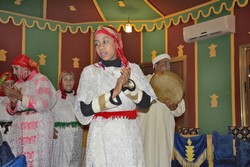Richer rites and rituals with gender variance
Cultural practices form an important part of a nation’s identity, yet are often overlooked and understudied. There is a particularly fascinating and intricate culture that thrives among the less privileged communities of society, one that should be highlighted for its richness. The EU-funded DRUM (Disguise ritual music) project studied examples of cultures that embrace disguise, music and gender variance in both northern Italy and Morocco from a sociological and historical perspective. The project team conducted research on spiritual and folkloric rituals that involve women and effeminate men or cross-dressers. One important example researched in Morocco is related to celebrations of the Birth of the Prophet (Mawlid) in different regions. Involving rites and dances in both domestic and public spaces, the celebrations feature both women and effeminate men in a musical context. The research also looked at the use of clay drums played by women during certain rituals and events. Using film, existing literature and ethnoarchaeology, the DRUM team documented these practices extensively, including as well how female potters in northern Morocco produce clay drums for ritual purposes. The research highlighted the important role of women and effeminate men, their belief in possession by spirits and related key pilgrimage sites. Researcher exchanges also led to scholars from Morocco heading to northern Italy for similar studies. The Moroccan team looked at the culture and rites of the region, including musical traditions, carnival rites, ‘femminielli’ and pilgrimage sites. A major part of the project, supported by workshops and seminars, was devoted to the lives and practices of cross-gender identities in relation to musical rites. The research also extended to the role of women who exhibit masculine behaviours in ritual or cultural contexts. The interdisciplinary approach combined anthropology, gender studies, psychology, history, religion, musicology and ethnomusicology to achieve its aims. These results are important in highlighting common trends in different cultures, reinforcing at the same time new methodologies for intercultural research. Lastly, DRUM research contributes to demystifying gender variance, which has been around for centuries, helping to free it from conservative perspectives on the topic.
Keywords
Rituals, gender variance, cross-dressing, culture, DRUM, disguise, effeminate men

